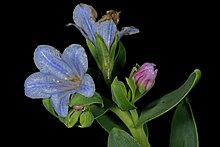| Lobostemon | |
|---|---|
 | |
| Lobostemon glaucophyllus | |
| Scientific classification | |
| Kingdom: | Plantae |
| Clade: | Tracheophytes |
| Clade: | Angiosperms |
| Clade: | Eudicots |
| Clade: | Asterids |
| Order: | Boraginales |
| Family: | Boraginaceae |
| Genus: | Lobostemon Lehm. (1830) |
| Species [1] | |
30; see text | |
| Synonyms [2] [1] | |
| |


Lobostemon is a genus of flowering plants belonging to the family Boraginaceae. It is endemic to the Cape Provinces of South Africa. [1] The majority of species are limited to the winter rainfall area of the country, from Springbok to Mossel Bay. [3] In Afrikaans these species are known as agtdaegeneesbos, [4] or loosely translated, bush that will heal in eight days. As this name suggests, many species have medicinal properties. This is best known from Lobostemon fruticosus, which is used for treating wounds, blood poisoning, ringworm, skin diseases and syphilis. [3]